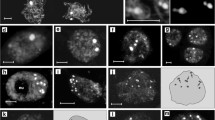Abstract
A Giemsa banding technique has been used to study C-banding in mitotic chromosomes in root tips of Fritillaria graeca, F. crassifolia and F. rhodocanakis, all diploids (2n=24) belonging to the graeca group. In the first two the C-bands were of two types, diverging in respect of staining regularly and specifically within chromosomes. In one type it was weak, being intermediate between that of intensely stained ones, representing the other class, and the euchromatin. In F. graeca the pale bands were proximally localized and confined to 5 pairs, whereas in F. crassifolia they occurred only in the 4 M chromosomes, in each within the centromeric constriction as a large inclusion. The interphase nuclei of both species contained pale and heavily stained chromocentres. No pale ones occurred in such nuclei of F. rhodocanakis. The probability is discussed that the two classes of C-band represent distinct types of heterochromatin, differing both in respect of condensation throughout the whole mitotic cycle and in the repetitive DNA sequences they most likely contain. In all 3 species pairs of Giemsa-positive centromeric dots, representing the centromeres, were masked both by proximally or centromerically localized bands, irrespective of the class of heterochromatin they represented.
Similar content being viewed by others
References
Cullis, C.A., Schweizer, D.: Repititious DNA in some Anemone species. Chromosoma (Berl.) 44, 417–421 (1974)
Darlington, C.D.: Recent advances in cytology. London: Churchill 1937
Darlington, C.D., La Cour, L.F.: The detection of inert genes. J. Hered. 32, 115–121 (1941)
Darlington, C.D., La Cour, L.F.: The handling of chromosomes. 6th Edit. London: Allen and Unwin 1977
Eiberg, H.: New selective techniques for human chromosomes, Cd staining. Nature (Lond.) 248, 55 (1974)
Flavell, R.B., Smith, D.B.: Nucleotide sequence organisation in the wheat genome. Heredity 37, 231–252 (1976)
Gallagher, A., Hewitt, G., Gibson, I.: Differential Giemsa staining of heterochromatic B-chromosomes in Myrmeleotettix maculatus (Thunb.) (Orthoptera: Acrididae). Chromosoma (Berl.) 40, 167–172 (1973)
Gill, G., Srivastava, P.K.: A simple technique for demonstrating heterochromatin in Nigella. Experientia (Basel) 30, 1483 (1974)
Gilot-Delhalle, J., Degraeve, N., Moutschen, J.: Cytotaxonomic investigation of the genus Nigella (Helloboreae) with C-banding technique. Caryologia (Firenze) 29, 139–153 (1976)
Holmquist, G.: Organisation and evolution of Drosophila virilis heterochromatin. Nature (Lond.) 257, 503–506 (1975)
Jones, K.W.: Chromosomal and nuclear location of mouse satellite DNA in individual cells. Nature (Lond.) 225, 912–915 (1970)
Klášterská, I., Natarajan, A.T.: Distribution of heterochromatin in chromosomes of Nigella damascena and Vicia faba. Hereditas (Lund) 79, 154–155 (1975)
La Cour, L.F.: Heterochromatin and the organisation of nucleoli in plants. Heredity 5, 37–50 (1951)
La Cour, L.F., Wells, B.: Fine structure and staining behaviour of heterochromatic segments in two plants. J. Cell Sci. 14, 1–17 (1974)
La Cour, L.F., Wells, B.: Some morphological aspects of the synaptonemal complex in higher plants. Phil. Trans. B 277, 259–266 (1977)
Macgregor, H.C., Horner, H., Owen, C.A., Parker, I.: Observations on centromeric heterochromatin and satellite DNA in salamanders of the genus Plethodon. Chromosoma (Berl.) 43, 329–348 (1973)
Marks, G.E.: The Giemsa-staining centromeres of Nigella damascena. J. Cell Sci. 18, 19–25 (1975)
Marks, G.E.: The nature of centromeric dots in Nigella chromosomes. Chromosoma (Berl.) 62, 369–373 (1977)
Narayan, R.K.J., Rees, H.: Nuclear DNA variation in Lathyrus. Chromosoma (Berl.) 54, 141–154 (1976)
Pardue, M.L., Gall, J.G.: Chromosomal localization of mouse satellite DNA. Science 168, 1356–1358 (1977)
Peacock, W.J., Brutlag, D., Goldring, E., Appels, R.A., Hinton, C.W., Lindsley, D.L.: The organization of highly repeated DNA sequences in Drosophila melanogaster chromosomes. Cold. Spr. Harb. Symp. quant. Biol. 38, 405–416 (1973)
Rix, M.: Fritillary co-operative exhibit. In: Lilies and other Liliaceae (E. Napier and J. Platt, eds.). Roy. Hort. Soc. (Lond.) 45–53 (1975)
Schweizer, D.: Differential staining of plant chromosomes with Giemsa. Chromosoma (Berl.) 40, 307–320 (1973)
Smith, D.B., Flavell, R.B.: Nucleotide sequence organisation in the Rye genome. Biochim. biophys. Acta (Amst.) 474, 82–97 (1977)
Stack, S.M.: Differential Giemsa staining of kinetochores and nucleolus organiser heterochromatin in mitotic chromosomes of higher plants. Chromosoma (Berl.) 47, 361–378 (1974)
Vosa, C.G.: Heterochromatin recognition with fluorochromes. Chromosoma (Berl.) 30, 366–372 (1970)
Vosa, C.G.: Heterochromatin recognition and analysis of chromosome variation in Scilla sibirica. Chromosoma (Berl.) 43, 269–278 (1973)
Author information
Authors and Affiliations
Rights and permissions
About this article
Cite this article
La Cour, L.F. Two types of constitutive heterochromatin in the chromosomes of some Fritillaria species. Chromosoma 67, 67–75 (1978). https://doi.org/10.1007/BF00285649
Received:
Accepted:
Issue Date:
DOI: https://doi.org/10.1007/BF00285649




